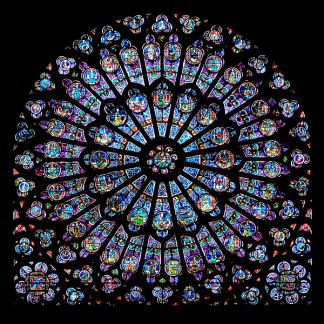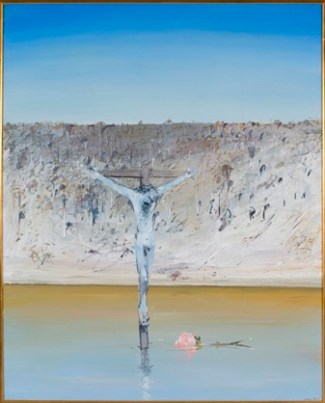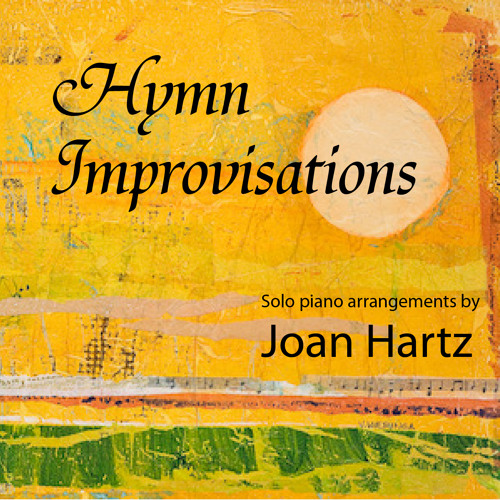One of my favorite Christmas songs is Es ist ein Ros entsprungen. It’s a late-sixteenth-century German hymn of unknown authorship, inspired by the Messianic prophecy of Isaiah 11:1: “A shoot will come up from the stump of Jesse; from his roots a Branch will bear fruit.” The harmonies were arranged by Michael Paretorius in 1609. Since then, there have been sixteen known English translations/adaptations of the carol, but the most famous one is “Lo, How a Rose E’er Blooming” by Theodore Baker in 1894. Some other translations are “Behold, a Branch Has Flowered,” “The Noble Stem of Jesse,” “A Spotless Rose is Blowing,” “The World’s Fair Rose,” and “There is a Rose Tree Blooming.”
Below is a recording by John Rutter and the Cambridge Singers, as well as an indie rendition by Sufjan Stevens.
Lo, how a rose e’er blooming,
From tender stem hath sprung.
Of Jesse’s lineage coming,
As men of old have sung;
It came, a flow’ret bright,
Amid the cold of winter,
When half spent was the night.Isaiah ’twas foretold it,
The Rose I have in mind,
With Mary we behold it,
The virgin mother kind;
To show God’s love aright,
She bore to men a Savior,
When half spent was the night.O Flower, whose fragrance tender
With sweetness fills the air,
Dispel with glorious splendour
The darkness everywhere;
True man, yet very God,
From sin and death now save us,
And share our every load.

Josef Sebastian Klauber, Rosa Mystica, 18th century. Engraving from the Litany of Loreto, The Marian Library, University of Dayton, Ohio.
Traditionally, Christian writers and artists have used the rose as a symbol for Mary, not Christ. She is sometimes called “Our Lady of the Roses,” “the Mystical Rose,” or “the Queen of the Rosary,” and roses played a key role in her alleged appearance at Guadalupe in the sixteenth century. According to the Rev. Theodore A. Koehler, the comparison stretches as far back as 150 AD, when Justin Martyr first used it. The Latin poet Sedulius poeticized the metaphor in his Carmen Paschale in the fifth century; St. Bernard of Clairvaux and Dante (Paradiso) also adopted it. Moreover, there exist several traditional carols (especially from England and Germany) about Mary, the Rose, such as “There is No Rose of Such Virtue” from around 1420: “There is no rose of such virtue / As is the rose that bare Jesu; / Alleluia. / For in this rose contained was / Heaven and earth in little space; / Res miranda. / By that rose we may well see / That he is God in persons three, / Pari forma.” etc. Such poems glorify Mary by placing her at the center of the Christmas story and emphasizing her critical role in the bringing about of salvation to the world.
However, around the fifteenth century (at least that’s as early as I could find), poets began drawing Jesus into this floral imagery, or at least making the metaphor of “the Rose” more ambiguous. For example, in the fifteenth-century carol “Of a Rose, a lovely Rose,” the “Rose” is both Mary and Jesus. The following is a translation by Brian Stone. (To read it in its original Middle English, visit Bartleby.com.)
Listen, nobles old and young,
How this rose at outset sprung;
In all this world I know of none
I so desire as that fair rose.
Of a Rose, a lovely Rose,
Of a Rose is all my song.
The angel came from heaven’s tower
To honour Mary in her bower,
And said that she should bear the flower
To break the Devil’s chain of woes.
Of a Rose, a lovely Rose,
Of a Rose is all my song.
In Bethlehem that flower was seen,
A lovely blossom bright of sheen.
The rose is Mary, heaven’s Queen;
Out of her womb that blossom rose.
Of a Rose, a lovely Rose,
Of a Rose is all my song.
The first branch is full of might,
That sprouted on the Christmas night
When star of Bethlehem shone bright,
For far and wide its lustre shows.
Of a Rose, a lovely Rose,
Of a Rose is all my song.
The second branch sprang forth to hell,
The Devil’s fearful power to quell,
And there henceforth no soul could dwell.
Blessed the coming of that rose!
Of a Rose, a lovely Rose,
Of a Rose is all my song.
To heaven sprang the third shoot,
Sweet and fair, both stem and root,
To dwell therein and bring us good:
In priestly hands it daily shows.
Of a Rose, a lovely Rose,
Of a Rose is all my song.
Let us then with honour pray
To her who is our help and stay,
And turns us from the Devil’s way.
From her that holy bloom arose.
Of a Rose, a lovely Rose,
Of a Rose is all my song.
As the Protestant Reformation got underway, references to Jesus as “the Christmas Rose” became more common. Below are some carols I found that develop that image. Most are available for listening on YouTube, or as MIDI files, but I’ve also put together a playlist on Spotify. (Spotify is a music-streaming service that you can download for free. If you’re already a user, click here to access the “Christmas Rose” playlist.) Many of these songs were originally written during the Middle Ages or Renaissance and have since been adapted numerous times.
- Maria durch einen Dornenwald ging (“Maria Walks Amid the Thorn”)—traditional sixteenth-century German carol; translated by Henry S. Drinker
- Virga Jesse floruit (“The Branch from Jesse Blooms”)—traditional Latin text; set by William Byrd (1605), J. S. Bach (1723), and Anton Bruckner (1885)
- El desembre congelat (“The Icy December”)—traditional Catalonian carol; arranged by Abel DiMarco, Ian R. Charter, and Robert Sieving
- “A Spotless Rose”—traditional German carol; translated by Catherine Winkworth, 1869; arranged by Herbert Howells, 1919
- Gesù bambino (“The Infant Jesus,” or “When Blossoms Flowered ’Mid the Snows”)—words and music by Pietro Yon, 1917; translated by Frederick H. Martens
- Den yndigste rose er funden (“Now Found is the Fairest of Roses”)—music by O. Ahnfelt, 1918; words by Hans Adolf Brorson; translated by C. Doving
- “The Rose”—words and music by John Paynter, 1969
- “A Rose Tree Blossoms” (Op. 246, No. 4)—words and music by Alan Hovhaness, 1973
- “There is a Flower”—words by John Audelay, 1426; arranged by John Rutter, 1986
- “Of a Rose, a Lovely Rose”—traditional English carol; arranged by John Rutter, 1990 (from his Magnificat)
- “Rose of Bethlehem”—words and music by Lowell Alexander, 1992; performed by Selah, 2002
Of these eleven, I think that the loveliest in terms of theological substance is “Now found is the fairest of roses.” But in terms of imagery, I really like “Maria Walks Amid the Thorn”:
Maria walks amid the thorn,
Kyrie eleison.
Maria walks amid the thorn,
Which seven years no leaf has born.
Jesus and Maria.What ‘neath her heart doth Mary bear?
Kyrie eleison.
A little child doth Mary bear,
Beneath her heart He nestles there.
Jesus and Maria.And as the two are passing near,
Kyrie eleison,
Lo! roses on the thorns appear,
Lo! roses on the thorns appear.
Jesus and Maria.
In this carol, the writer uses synecdoche in casting Mary as a stand-in for the nation of Israel as a whole. When God cursed the ground in Genesis 3:18, he said that it would thenceforth produce thorns and thistles. Thorns have thus come to symbolize, in the Judeo-Christian tradition, the hardships and suffering brought about by the sin of man. Israel knew the meaning of suffering as well as anyone. All the way back to Abraham, they had been waiting and waiting and waiting for the deliverance that God had promised them, without any fruition (“no leaf”). For seven long years they’d been waiting. (Here the “seven” is not literal, but signifies a long passage of time, similar to Jesus’s use of the number in Matthew 18:22; the number also signifies perfection, completion, meaning that Israel’s period of waiting was blessed by God and is finally about to bear fruit.)
As a child, Mary walked among the same thorns that strewed the ground her ancestors had walked. Not even she, favored though she was, was exempt from the curse. This is the first verse. But in verse 2, Mary gives birth to the long-awaited Savior; she holds him gently to her breast, as she would a rose, for he is her beauty, her glory, her redemption, and indeed that of all of Israel’s. Verse 3 reminds us that although life will continue to bear thorns, there is mercy to be had, and life and beauty to be experienced, through Jesus. Because he, too, walked among the thorns, only he encountered them in a very direct and literal way, all so that we could escape the curse.
If we were to reconcile all the Catholic and Protestant hymns to one another, we would see that there does arise one cohesive “Christmas Rose” image: A plant (the Tree of Jesse, or, perhaps more appropriately, the Rosebush of Jesse), springing up from Israeli soil. God is the seed, Jesse and others (Abraham, Moses, David, etc.) are the roots, Mary is the stem, and Jesus is the crowning blossom. All the people in the lineage of Christ helped bring him into the world and make up this giant, leafy, flowering plant. And now non-Jews are being graciously grafted in (Romans 11).
What most of these carols have in common is the simple picture of a rose sprouting up from a bed of snow. I think of Jesus, who came into this cold world so gently, so sweetly, and with a beautiful bloom. I think of how his petals were later squeezed and crushed on the cross to make for us a fragrant salvationary oil. But I also think of how, though crushed, he is still alive, and how he continues to plant himself in the hearts of men. And there he stays “e’er blooming.”
Two very helpful sources for this post were “The Christian Symbolism of the Rose: Our Lady and the Rose” by Rev. Theodore A. Koehler, and HymnsandCarolsofChristmas.com.







Pingback: The Art of Notre Dame de France, London | The Jesus Question
Pingback: Jesus as the Root/Shoot/Branch of Jesse | The Jesus Question
Pingback: Christmas Concentration – Children's Ministry in St Albans Diocese